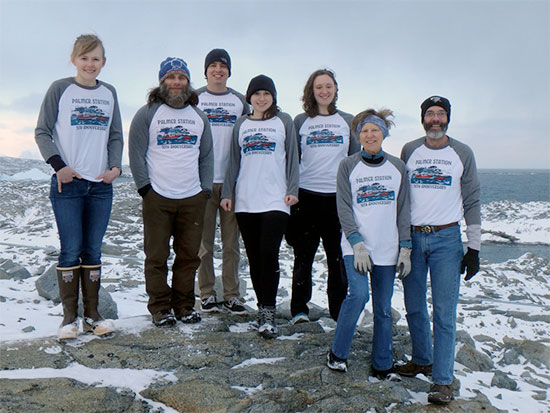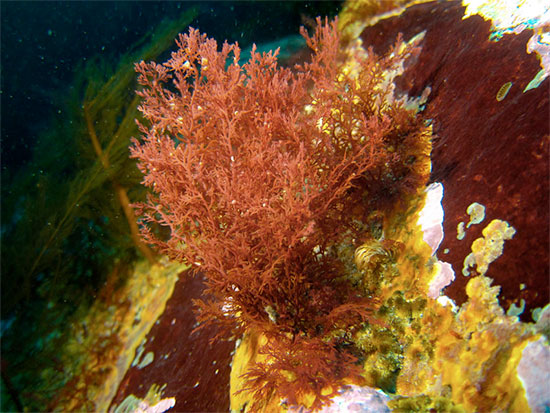 Group photo: C.J. Brothers, Ph.D., collaborating researcher and UAB alumna; Keith Smith, PolarTREC teacher; Andrew Shilling, graduate student from the University of South Florida; Michelle Curtis, UAB graduate research assistant; Sabrina Heiser, UAB graduate research assistant; Maggie Amsler, UAB research associate; Chuck Amsler, Ph.D., professor in the UAB Department of BiologyMarine biologists from the University of Alabama at Birmingham landed on the White Continent by way of Punta Arenas, Chile, for a research expedition in February. Over 16 weeks, the team of six explorers spent the 2018 field season at Palmer Station researching the ecology of the very rich Antarctic seafloor communities to learn how important ecological interactions in those communities are structured through the production of chemical defenses against predation.
Group photo: C.J. Brothers, Ph.D., collaborating researcher and UAB alumna; Keith Smith, PolarTREC teacher; Andrew Shilling, graduate student from the University of South Florida; Michelle Curtis, UAB graduate research assistant; Sabrina Heiser, UAB graduate research assistant; Maggie Amsler, UAB research associate; Chuck Amsler, Ph.D., professor in the UAB Department of BiologyMarine biologists from the University of Alabama at Birmingham landed on the White Continent by way of Punta Arenas, Chile, for a research expedition in February. Over 16 weeks, the team of six explorers spent the 2018 field season at Palmer Station researching the ecology of the very rich Antarctic seafloor communities to learn how important ecological interactions in those communities are structured through the production of chemical defenses against predation.
The veteran team, which has been engaged in research expeditions to Palmer Station for 19 years, focused their research on the continuing studies of the National Science Foundation-funded research program on the chemical ecology of Antarctic marine algae and invertebrates.
“We accomplished all of our primary goals this field season, along with a majority of our second-level set of experimental priorities,” said Chuck Amsler, Ph.D., professor in the UAB College of Arts and Sciences Department of Biology and co-leader of the expedition. “There are many experiments that can only be conducted in Antarctica. Our research is important to understanding these vibrant communities, and we use unique features of Antarctica as tools that allow us to learn things that are applicable worldwide but can best be studied there. The highlight of this season was the completion of a yearlong experiment that is a major part of Sabrina Heiser’s dissertation project.”
Algae chemical variations: genetic or environmental
Heiser, a graduate research assistant from UAB, focuses much of her research on the transplantation of Ploc, her nickname for a species of red algae. The algae is placed on racks attached to submerged concrete slabs called substrates. Previous experiments with the algae have been conducted for only 10 weeks at a time in good weather. In 2017, the team spent a great deal of time in Antarctica determining a good location for a yearlong study.
Leaving the red algae on the substrates all year put the experiment in danger from the harshness of the Antarctic winter, including destruction by winter storms, icebergs’ crunching them, the cable ties’ becoming brittle and snapping, or any other phenomenon of nature.
|
Learn more about McClintock’s SCAR Medal for Education and Communication. |
“On our first dive, we went to the most vulnerable site and found the substrates intact,” Heiser said. “Our subsequent dives found all 14 substrates across three different sites intact, allowing us to continue with our research to look at the chemicals that these algae produce to protect themselves against predators.”
Since algae and other immobile organisms are unable to run from predators, they produce harmful chemicals to protect themselves. Different types of algae produce different types of defensive chemicals, all of which have an impact on the ecosystem. Heiser is looking at why there is such a high diversity in defensive chemicals. The yearlong experiment will help determine if the diversity is based on genetics or on environmental influence.
Upon initial retrieval, the team measured growth and took samples for chemical analysis, which are currently being analyzed by investigators at the University of South Florida.
Snails’ lifecycle on macroalgae
UAB researchers in Antarctica looked at how numerous small gastropods, or snails, help the macroalgae they live on. These snails do not appear to eat the macroalgae but rather consume small algae that might otherwise overgrow them.
 Sabrina Heiser focuses her researchers on the chemicals produces in various climates by red algae.“We hypothesized that the gastropods would benefit the algal hosts, and we saw that this could potentially be true,” Amsler said. “We brought back samples last year that were investigated in labs at UAB to determine how many of the snails live on the algae. This year, we ran experiments in aquaria with or without those densities of snails to test the feasibility of this hypothesis.”
Sabrina Heiser focuses her researchers on the chemicals produces in various climates by red algae.“We hypothesized that the gastropods would benefit the algal hosts, and we saw that this could potentially be true,” Amsler said. “We brought back samples last year that were investigated in labs at UAB to determine how many of the snails live on the algae. This year, we ran experiments in aquaria with or without those densities of snails to test the feasibility of this hypothesis.”
Amsler noted that, from prior research, they know other small, shrimp-like animals are important in allowing some of the ecologically dominant macroalgal species to grow free of the small algal competitors. But other, wider-bladed macroalgae that play similar ecologically important roles in deeper water are not hosts to as many of these protective shrimp-like animals. Their research this year showed that the snails filled the same role and allowed these wider, deeper-growing algae to dominate where they occur.
Antarctica educational efforts recognized internationally
James McClintock, Ph.D., Endowed Professor of Polar and Marine Biology, is the inaugural recipient of the 2018 SCAR Medal for Education and Communication, awarded by the Scientific Committee on Antarctic Research, for his decadeslong educational efforts emphasizing Antarctic climate change and impacts on marine biology. The medal was awarded June 21 during the Polar 2018 Conference Dinner in Davos, Switzerland.
“What I like most about this award is that its creation reflects the growing recognition across the scientific community that science education and communication are essential elements to effectively addressing pressing issues of science in today’s world,” McClintock said. “My teaching philosophy is rooted in hands-on experiential learning and, increasingly, the use of storytelling to engage a class of students or the general public. Already, the award has generated an invitation to speak to a group of international teachers who participated in the SCAR conference.”
Members of the 2018 expedition team include James McClintock; Chuck Amsler; Maggie Amsler, a research associate in the UAB Department of Biology; Michelle Curtis, a graduate research assistant from UAB; Sabrina Heiser; and Cecilia Brothers, Ph.D., collaborating researcher and UAB alumna.
